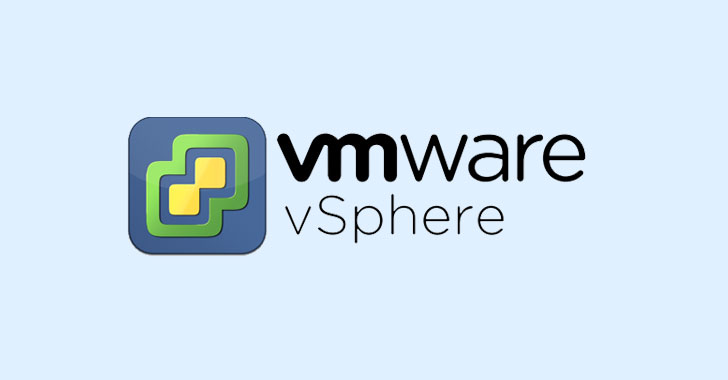
VMware Warns of Critical File Upload Vulnerability Affecting vCenter Server
9.8 High
CVSS3
Attack Vector
NETWORK
Attack Complexity
LOW
Privileges Required
NONE
User Interaction
NONE
Scope
UNCHANGED
Confidentiality Impact
HIGH
Integrity Impact
HIGH
Availability Impact
HIGH
CVSS:3.1/AV:N/AC:L/PR:N/UI:N/S:U/C:H/I:H/A:H
9 High
CVSS2
Access Vector
NETWORK
Access Complexity
LOW
Authentication
SINGLE
Confidentiality Impact
COMPLETE
Integrity Impact
COMPLETE
Availability Impact
COMPLETE
AV:N/AC:L/Au:S/C:C/I:C/A:C
VMware on Tuesday published a new bulletin warning of as many as 19 vulnerabilities in vCenter Server and Cloud Foundation appliances that a remote attacker could exploit to take control of an affected system.
The most urgent among them is an arbitrary file upload vulnerability in the Analytics service (CVE-2021-22005) that impacts vCenter Server 6.7 and 7.0 deployments. “A malicious actor with network access to port 443 on vCenter Server may exploit this issue to execute code on vCenter Server by uploading a specially crafted file,” the company noted, adding “this vulnerability can be used by anyone who can reach vCenter Server over the network to gain access, regardless of the configuration settings of vCenter Server.”
Although VMware has published workarounds for the flaw, the company cautioned that they are “meant to be a temporary solution until updates […] can be deployed.”
The complete list of flaws patched by the virtualization services provider is as follows —
- CVE-2021-22005 (CVSS score: 9.8) - vCenter Server file upload vulnerability
- CVE-2021-21991 (CVSS score: 8.8) - vCenter Server local privilege escalation vulnerability
- CVE-2021-22006 (CVSS score: 8.3) - vCenter Server reverse proxy bypass vulnerability
- CVE-2021-22011 (CVSS score: 8.1) - vCenter server unauthenticated API endpoint vulnerability
- CVE-2021-22015 (CVSS score: 7.8) - vCenter Server improper permission local privilege escalation vulnerabilities
- CVE-2021-22012 (CVSS score: 7.5) - vCenter Server unauthenticated API information disclosure vulnerability
- CVE-2021-22013 (CVSS score: 7.5) - vCenter Server file path traversal vulnerability
- CVE-2021-22016 (CVSS score: 7.5) - vCenter Server reflected XSS vulnerability
- CVE-2021-22017 (CVSS score: 7.3) - vCenter Server rhttpproxy bypass vulnerability
- CVE-2021-22014 (CVSS score: 7.2) - vCenter Server authenticated code execution vulnerability
- CVE-2021-22018 (CVSS score: 6.5) - vCenter Server file deletion vulnerability
- CVE-2021-21992 (CVSS score: 6.5) - vCenter Server XML parsing denial-of-service vulnerability
- CVE-2021-22007 (CVSS score: 5.5) - vCenter Server local information disclosure vulnerability
- CVE-2021-22019 (CVSS score: 5.3) - vCenter Server denial of service vulnerability
- CVE-2021-22009 (CVSS score: 5.3) - vCenter Server VAPI multiple denial of service vulnerabilities
- CVE-2021-22010 (CVSS score: 5.3) - vCenter Server VPXD denial of service vulnerability
- CVE-2021-22008 (CVSS score: 5.3) - vCenter Server information disclosure vulnerability
- CVE-2021-22020 (CVSS score: 5.0) - vCenter Server Analytics service denial-of-service vulnerability
- CVE-2021-21993 (CVSS score: 4.3) - vCenter Server SSRF vulnerability
Credited with reporting most of the flaws are George Noseevich and Sergey Gerasimov of SolidLab LLC, alongside Hynek Petrak of Schneider Electric, Yuval Lazar of Pentera, and Osama Alaa of Malcrove.
“The ramifications of [CVE-2021-22005] are serious and it is a matter of time – likely minutes after the disclosure – before working exploits are publicly available,” VMware said in an FAQ urging customers to immediately update their vCenter installations.
“With the threat of ransomware looming nowadays the safest stance is to assume that an attacker may already have control of a desktop and a user account through the use of techniques like phishing or spear-phishing, and act accordingly. This means the attacker may already be able to reach vCenter Server from inside a corporate firewall, and time is of the essence,” the company added.
Found this article interesting? Follow THN on Facebook, Twitter and LinkedIn to read more exclusive content we post.
9.8 High
CVSS3
Attack Vector
NETWORK
Attack Complexity
LOW
Privileges Required
NONE
User Interaction
NONE
Scope
UNCHANGED
Confidentiality Impact
HIGH
Integrity Impact
HIGH
Availability Impact
HIGH
CVSS:3.1/AV:N/AC:L/PR:N/UI:N/S:U/C:H/I:H/A:H
9 High
CVSS2
Access Vector
NETWORK
Access Complexity
LOW
Authentication
SINGLE
Confidentiality Impact
COMPLETE
Integrity Impact
COMPLETE
Availability Impact
COMPLETE
AV:N/AC:L/Au:S/C:C/I:C/A:C
